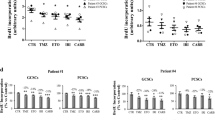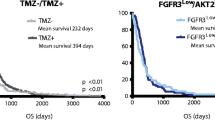Abstract
In spite of considerable research into the therapies for glioblastoma multiforme this tumour type remains very difficult to treat. As well as having a tendency to be inherently resistant to chemotherapy, glioblastoma multiforme also displays local invasion. Cell line studies have a continued and important role to play in understanding the mechanisms associated with both chemotherapy resistance and invasion. In the current study we have utilized the C6 glioma cell line to investigate the response to long-term, clinically relevant application of topoisomerase I and II inhibitors. Treatment with etoposide resulted in an increase in resistance to this topoisomerase II inhibitor. By contrast, the continuous exposure to a topoisomerase I inhibitor did not result in increased drug resistance, but was associated with a reduction in cell migration. This data supports further investigation of topoisomerase I inhibition as a means to inhibit glioma invasion without the development of parallel chemoresistance.





Similar content being viewed by others

References
Dolecek TA, Propp JM, Stroup NE, Kruchko C (2012) CBTRUS statistical report: primary brain and central nervous system tumors diagnosed in the United States in 2005–2009. Neuro-Oncol 14(Suppl 5):v1–49. doi:10.1093/neuonc/nos218
Stupp R, Mason WP, van den Bent MJ, Weller M, Fisher B, Taphoorn MJ, Belanger K, Brandes AA, Marosi C, Bogdahn U, Curschmann J, Janzer RC, Ludwin SK, Gorlia T, Allgeier A, Lacombe D, Cairncross JG, Eisenhauer E, Mirimanoff RO (2005) Radiotherapy plus concomitant and adjuvant temozolomide for glioblastoma. New Engl J Med 352:987–996. doi:10.1056/NEJMoa043330
Gilbert MR, Wang M, Aldape KD, Stupp R, Hegi ME, Jaeckle KA, Armstrong TS, Wefel JS, Won M, Blumenthal DT, Mahajan A, Schultz CJ, Erridge S, Baumert B, Hopkins KI, Tzuk-Shina T, Brown PD, Chakravarti A, Curran WJ Jr, Mehta MP (2013) Dose-dense temozolomide for newly diagnosed glioblastoma: a randomized phase III clinical trial. J Clin Oncol 31:4085–4091. doi:10.1200/JCO.2013.49.6968
Haar CP, Hebbar P, Wallace GCt, Das A, Vandergrift WA, 3rd, Smith JA, Giglio P, Patel SJ, Ray SK, Banik NL (2012) Drug resistance in glioblastoma: a mini review. Neurochem Res 37: 1192–1200 doi:10.1007/s11064-011-0701-1
Cuddapah VA, Robel S, Watkins S, Sontheimer H (2014) A neurocentric perspective on glioma invasion. Nat Rev Neurosci 15:455–465. doi:10.1038/nrn3765
Paw I, Carpenter RC, Watabe K, Debinski W, Lo HW (2015) Mechanisms regulating glioma invasion. Cancer Lett 362:1–7. doi:10.1016/j.canlet.2015.03.015
Sanai N, Berger MS (2008) Glioma extent of resection and its impact on patient outcome. Neurosurgery 62:753–764. doi:10.1227/01.neu.0000318159.21731.cf
Prabhu S, Harris F, Lea R, Snape TJ (2014) Small-molecule clinical trial candidates for the treatment of glioma. Drug Discovery Today 19:1298–1308. doi:10.1016/j.drudis.2014.02.007 discussion 264–756
Chikamori K, Grabowski DR, Kinter M, Willard BB, Yadav S, Aebersold RH, Bukowski RM, Hickson ID, Andersen AH, Ganapathi R, Ganapathi MK (2003) Phosphorylation of serine 1106 in the catalytic domain of topoisomerase II alpha regulates enzymatic activity and drug sensitivity. J Biol Chem 278:12696–12702. doi:10.1074/jbc.M300837200
Adachi N, Suzuki H, Iiizumi S, Koyama H (2003) Hypersensitivity of nonhomologous DNA end-joining mutants to VP-16 and ICRF-193: implications for the repair of topoisomerase II-mediated DNA damage. J Biol Chem 278:35897–35902. doi:10.1074/jbc.M306500200
Benda P, Lightbody J, Sato G, Levine L, Sweet W (1968) Differentiated rat glial cell strain in tissue culture. Science 161:370–371
Schmidek HH, Nielsen SL, Schiller AL, Messer J (1971) Morphological studies of rat brain tumors induced by N-nitrosomethylurea. J Neurosurg 34:335–340. doi:10.3171/jns.1971.34.3.0335
Auer RN, Del Maestro RF, Anderson R (1981) A simple and reproducible experimental in vivo glioma model. Can J Neurol Sci Le J Can des Sci Neurol 8:325–331
Barth RF, Kaur B (2009) Rat brain tumor models in experimental neuro-oncology: the C6, 9L, T9, RG2, F98, BT4C, RT-2 and CNS-1 gliomas. J Neurooncol 94:299–312. doi:10.1007/s11060-009-9875-7
Hande KR (1998) Etoposide: four decades of development of a topoisomerase II inhibitor. Eur J Cancer 34:1514–1521
Pollack IF, Erff M, Bom D, Burke TG, Strode JT, Curran DP (1999) Potent topoisomerase I inhibition by novel silatecans eliminates glioma proliferation in vitro and in vivo. Cancer Res 59:4898–4905
Vandesompele J, De Preter K, Pattyn F, Poppe B, Van Roy N, De Paepe A, Speleman F (2002) Accurate normalization of real-time quantitative RT-PCR data by geometric averaging of multiple internal control genes. Genome Biol 3: RESEARCH0034
Pfaffl MW (2001) A new mathematical model for relative quantification in real-time RT-PCR. Nucleic Acids Res 29:e45
Franken NA, Rodermond HM, Stap J, Haveman J, van Bree C (2006) Clonogenic assay of cells in vitro. Nat Protoc 1:2315–2319. doi:10.1038/nprot.2006.339
Kartner N, Riordan JR, Ling V (1983) Cell surface P-glycoprotein associated with multidrug resistance in mammalian cell lines. Science 221:1285–1288
Szakacs G, Paterson JK, Ludwig JA, Booth-Genthe C, Gottesman MM (2006) Targeting multidrug resistance in cancer. Nat Rev 5:219–234
Goldwirt L, Beccaria K, Carpentier A, Farinotti R, Fernandez C (2014) Irinotecan and temozolomide brain distribution: a focus on ABCB1. Cancer Chemother Pharmacol 74:185–193. doi:10.1007/s00280-014-2490-0
Achuthan S, Santhoshkumar TR, Prabhakar J, Nair SA, Pillai MR (2011) Drug-induced senescence generates chemoresistant stemlike cells with low reactive oxygen species. J Biol Chem 286:37813–37829. doi:10.1074/jbc.M110.200675
Kaufman LJ, Brangwynne CP, Kasza KE, Filippidi E, Gordon VD, Deisboeck TS, Weitz DA (2005) Glioma expansion in collagen I matrices: analyzing collagen concentration-dependent growth and motility patterns. Biophys J 89:635–650. doi:10.1529/biophysj.105.061994
Paulus W, Huettner C, Tonn JC (1994) Collagens, integrins and the mesenchymal drift in glioblastomas: a comparison of biopsy specimens, spheroid and early monolayer cultures. Int J Cancer 58:841–846
Coyle B, Kessler M, Sabnis DH, Kerr ID (2015) ABCB1 in children’s brain tumours. Biochem Soc Trans 43:1018–1022. doi:10.1042/BST20150137
Othman RT, Kimishi I, Bradshaw TD, Storer LC, Korshunov A, Pfister SM, Grundy RG, Kerr ID, Coyle B (2014) Overcoming multiple drug resistance mechanisms in medulloblastoma. Acta Neuropathol Commun 2:57. doi:10.1186/2051-5960-2-57
Colone M, Calcabrini A, Toccacieli L, Bozzuto G, Stringaro A, Gentile M, Cianfriglia M, Ciervo A, Caraglia M, Budillon A, Meo G, Arancia G, Molinari A (2008) The multidrug transporter P-glycoprotein: a mediator of melanoma invasion? J Invest Dermatol 128:957–971. doi:10.1038/sj.jid.5701082
Miletti-Gonzalez KE, Chen S, Muthukumaran N, Saglimbeni GN, Wu X, Yang J, Apolito K, Shih WJ, Hait WN, Rodriguez-Rodriguez L (2005) The CD44 receptor interacts with P-glycoprotein to promote cell migration and invasion in cancer. Cancer Res 65:6660–6667. doi:10.1158/0008-5472.CAN-04-3478
Acknowledgments
We deeply appreciate support from the Royal Thai government for a PhD scholarship for WP, and King Abdulaziz University for a PhD scholarship for ABA. This work was supported by funding from the Brain Tumour Charity (SDBTT 17/3). The authors are grateful to Dr Peter Jones (Life Sciences, University of Nottingham) for the generous donation of transwell migration plates.
Author information
Authors and Affiliations
Corresponding authors
Additional information
A. B. Al-Ghafari and W. Punjaruk have been contributed equally to data generation.
Electronic supplementary material
Below is the link to the electronic supplementary material.
Rights and permissions
About this article
Cite this article
Al-Ghafari, A.B., Punjaruk, W., Storer, L.C.D. et al. Long-term exposure to irinotecan reduces cell migration in glioma cells. J Neurooncol 127, 455–462 (2016). https://doi.org/10.1007/s11060-016-2058-4
Received:
Accepted:
Published:
Issue Date:
DOI: https://doi.org/10.1007/s11060-016-2058-4



